-
EXECUTIVE SUMMARY
-
Market Overview
-
Key Findings
-
Market Segmentation
-
Competitive Landscape
-
Challenges and Opportunities
-
Future Outlook
-
\r\n
-
MARKET INTRODUCTION
-
Definition
-
Scope of the study
- Research Objective
- Assumption
- Limitations
-
RESEARCH METHODOLOGY
-
Overview
-
Data Mining
-
Secondary Research
-
Primary Research
- Primary Interviews and Information Gathering Process
- Breakdown of Primary Respondents
-
Forecasting Model
-
Market Size Estimation
- Bottom-Up Approach
- Top-Down Approach
-
Data Triangulation
-
Validation
-
\r\n
-
MARKET DYNAMICS
-
Overview
-
Drivers
-
Restraints
-
Opportunities
-
MARKET FACTOR ANALYSIS
-
Value chain Analysis
-
Porter's Five Forces Analysis
- Bargaining Power of Suppliers
- Bargaining Power of Buyers
- Threat of New Entrants
- Threat of Substitutes
- Intensity of Rivalry
-
COVID-19 Impact Analysis
- Market Impact Analysis
- Regional Impact
- Opportunity and Threat Analysis
-
\r\n
-
ARMORED VEHICLE MARKET, BY APPLICATION (USD BILLION)
-
Military
-
Law Enforcement
-
Civil Defense
-
Private Security
-
Emergency Services
-
ARMORED VEHICLE MARKET, BY VEHICLE TYPE (USD BILLION)
-
Personnel Carriers
-
Main Battle Tanks
-
Armored Personnel Carriers
-
Mine-Resistant Ambush Protected Vehicles
-
Light Tactical Vehicles
-
ARMORED VEHICLE MARKET, BY MOBILITY TYPE (USD BILLION)
-
Wheeled
-
Tracked
-
Hybrid
-
ARMORED VEHICLE MARKET, BY ARMOR TYPE (USD BILLION)
-
Composite Armor
-
Ceramic Armor
-
Steel Armor
-
Spall Liner
-
ARMORED VEHICLE MARKET, BY REGIONAL (USD BILLION)
-
North America
- US
- Canada
-
Europe
- Germany
- UK
- France
- Russia
- Italy
- Spain
- Rest of Europe
-
APAC
- China
- India
- Japan
- South Korea
- Malaysia
- Thailand
- Indonesia
- Rest of APAC
-
South America
- Brazil
- Mexico
- Argentina
- Rest of South America
-
MEA
- GCC Countries
- South Africa
- Rest of MEA
-
\r\n
-
COMPETITIVE LANDSCAPE
-
Overview
-
Competitive Analysis
-
Market share Analysis
-
Major Growth Strategy in the Armored Vehicle Market
-
Competitive Benchmarking
-
Leading Players in Terms of Number of Developments in the Armored Vehicle Market
-
Key developments and growth strategies
- New Product Launch/Service Deployment
- Merger & Acquisitions
- Joint Ventures
-
Major Players Financial Matrix
- Sales and Operating Income
- Major Players R&D Expenditure. 2023
-
COMPANY PROFILES
-
BAE Systems
- Financial Overview
- Products Offered
- Key Developments
- SWOT Analysis
- Key Strategies
-
Navistar Defense
- Financial Overview
- Products Offered
- Key Developments
- SWOT Analysis
- Key Strategies
-
Elbit Systems
- Financial Overview
- Products Offered
- Key Developments
- SWOT Analysis
- Key Strategies
-
Rheinmetall
- Financial Overview
- Products Offered
- Key Developments
- SWOT Analysis
- Key Strategies
-
Lockheed Martin
- Financial Overview
- Products Offered
- Key Developments
- SWOT Analysis
- Key Strategies
-
Hanwha Defense
- Financial Overview
- Products Offered
- Key Developments
- SWOT Analysis
- Key Strategies
-
Leonardo
- Financial Overview
- Products Offered
- Key Developments
- SWOT Analysis
- Key Strategies
-
General Dynamics
- Financial Overview
- Products Offered
- Key Developments
- SWOT Analysis
- Key Strategies
-
Saab
- Financial Overview
- Products Offered
- Key Developments
- SWOT Analysis
- Key Strategies
-
Oshkosh Defense
- Financial Overview
- Products Offered
- Key Developments
- SWOT Analysis
- Key Strategies
-
Northrop Grumman
- Financial Overview
- Products Offered
- Key Developments
- SWOT Analysis
- Key Strategies
-
Textron
- Financial Overview
- Products Offered
- Key Developments
- SWOT Analysis
- Key Strategies
-
Mitsubishi Heavy Industries
- Financial Overview
- Products Offered
- Key Developments
- SWOT Analysis
- Key Strategies
-
KraussMaffei Wegmann
- Financial Overview
- Products Offered
- Key Developments
- SWOT Analysis
- Key Strategies
-
Thales Group
- Financial Overview
- Products Offered
- Key Developments
- SWOT Analysis
- Key Strategies
-
APPENDIX
-
References
-
Related Reports
-
\r\n
-
LIST OF TABLES
-
\r\n
-
LIST OF ASSUMPTIONS
-
NORTH AMERICA ARMORED VEHICLE MARKET SIZE ESTIMATES & FORECAST, BY APPLICATION, 2019-2035 (USD BILLIONS)
-
NORTH AMERICA ARMORED VEHICLE MARKET SIZE ESTIMATES & FORECAST, BY VEHICLE TYPE, 2019-2035 (USD BILLIONS)
-
NORTH AMERICA ARMORED VEHICLE MARKET SIZE ESTIMATES & FORECAST, BY MOBILITY TYPE, 2019-2035 (USD BILLIONS)
-
NORTH AMERICA ARMORED VEHICLE MARKET SIZE ESTIMATES & FORECAST, BY ARMOR TYPE, 2019-2035 (USD BILLIONS)
-
NORTH AMERICA ARMORED VEHICLE MARKET SIZE ESTIMATES & FORECAST, BY REGIONAL, 2019-2035 (USD BILLIONS)
-
US ARMORED VEHICLE MARKET SIZE ESTIMATES & FORECAST, BY APPLICATION, 2019-2035 (USD BILLIONS)
-
US ARMORED VEHICLE MARKET SIZE ESTIMATES & FORECAST, BY VEHICLE TYPE, 2019-2035 (USD BILLIONS)
-
US ARMORED VEHICLE MARKET SIZE ESTIMATES & FORECAST, BY MOBILITY TYPE, 2019-2035 (USD BILLIONS)
-
US ARMORED VEHICLE MARKET SIZE ESTIMATES & FORECAST, BY ARMOR TYPE, 2019-2035 (USD BILLIONS)
-
US ARMORED VEHICLE MARKET SIZE ESTIMATES & FORECAST, BY REGIONAL, 2019-2035 (USD BILLIONS)
-
CANADA ARMORED VEHICLE MARKET SIZE ESTIMATES & FORECAST, BY APPLICATION, 2019-2035 (USD BILLIONS)
-
CANADA ARMORED VEHICLE MARKET SIZE ESTIMATES & FORECAST, BY VEHICLE TYPE, 2019-2035 (USD BILLIONS)
-
CANADA ARMORED VEHICLE MARKET SIZE ESTIMATES & FORECAST, BY MOBILITY TYPE, 2019-2035 (USD BILLIONS)
-
CANADA ARMORED VEHICLE MARKET SIZE ESTIMATES & FORECAST, BY ARMOR TYPE, 2019-2035 (USD BILLIONS)
-
CANADA ARMORED VEHICLE MARKET SIZE ESTIMATES & FORECAST, BY REGIONAL, 2019-2035 (USD BILLIONS)
-
EUROPE ARMORED VEHICLE MARKET SIZE ESTIMATES & FORECAST, BY APPLICATION, 2019-2035 (USD BILLIONS)
-
EUROPE ARMORED VEHICLE MARKET SIZE ESTIMATES & FORECAST, BY VEHICLE TYPE, 2019-2035 (USD BILLIONS)
-
EUROPE ARMORED VEHICLE MARKET SIZE ESTIMATES & FORECAST, BY MOBILITY TYPE, 2019-2035 (USD BILLIONS)
-
EUROPE ARMORED VEHICLE MARKET SIZE ESTIMATES & FORECAST, BY ARMOR TYPE, 2019-2035 (USD BILLIONS)
-
EUROPE ARMORED VEHICLE MARKET SIZE ESTIMATES & FORECAST, BY REGIONAL, 2019-2035 (USD BILLIONS)
-
GERMANY ARMORED VEHICLE MARKET SIZE ESTIMATES & FORECAST, BY APPLICATION, 2019-2035 (USD BILLIONS)
-
GERMANY ARMORED VEHICLE MARKET SIZE ESTIMATES & FORECAST, BY VEHICLE TYPE, 2019-2035 (USD BILLIONS)
-
GERMANY ARMORED VEHICLE MARKET SIZE ESTIMATES & FORECAST, BY MOBILITY TYPE, 2019-2035 (USD BILLIONS)
-
GERMANY ARMORED VEHICLE MARKET SIZE ESTIMATES & FORECAST, BY ARMOR TYPE, 2019-2035 (USD BILLIONS)
-
GERMANY ARMORED VEHICLE MARKET SIZE ESTIMATES & FORECAST, BY REGIONAL, 2019-2035 (USD BILLIONS)
-
UK ARMORED VEHICLE MARKET SIZE ESTIMATES & FORECAST, BY APPLICATION, 2019-2035 (USD BILLIONS)
-
UK ARMORED VEHICLE MARKET SIZE ESTIMATES & FORECAST, BY VEHICLE TYPE, 2019-2035 (USD BILLIONS)
-
UK ARMORED VEHICLE MARKET SIZE ESTIMATES & FORECAST, BY MOBILITY TYPE, 2019-2035 (USD BILLIONS)
-
UK ARMORED VEHICLE MARKET SIZE ESTIMATES & FORECAST, BY ARMOR TYPE, 2019-2035 (USD BILLIONS)
-
UK ARMORED VEHICLE MARKET SIZE ESTIMATES & FORECAST, BY REGIONAL, 2019-2035 (USD BILLIONS)
-
FRANCE ARMORED VEHICLE MARKET SIZE ESTIMATES & FORECAST, BY APPLICATION, 2019-2035 (USD BILLIONS)
-
FRANCE ARMORED VEHICLE MARKET SIZE ESTIMATES & FORECAST, BY VEHICLE TYPE, 2019-2035 (USD BILLIONS)
-
FRANCE ARMORED VEHICLE MARKET SIZE ESTIMATES & FORECAST, BY MOBILITY TYPE, 2019-2035 (USD BILLIONS)
-
FRANCE ARMORED VEHICLE MARKET SIZE ESTIMATES & FORECAST, BY ARMOR TYPE, 2019-2035 (USD BILLIONS)
-
FRANCE ARMORED VEHICLE MARKET SIZE ESTIMATES & FORECAST, BY REGIONAL, 2019-2035 (USD BILLIONS)
-
RUSSIA ARMORED VEHICLE MARKET SIZE ESTIMATES & FORECAST, BY APPLICATION, 2019-2035 (USD BILLIONS)
-
RUSSIA ARMORED VEHICLE MARKET SIZE ESTIMATES & FORECAST, BY VEHICLE TYPE, 2019-2035 (USD BILLIONS)
-
RUSSIA ARMORED VEHICLE MARKET SIZE ESTIMATES & FORECAST, BY MOBILITY TYPE, 2019-2035 (USD BILLIONS)
-
RUSSIA ARMORED VEHICLE MARKET SIZE ESTIMATES & FORECAST, BY ARMOR TYPE, 2019-2035 (USD BILLIONS)
-
RUSSIA ARMORED VEHICLE MARKET SIZE ESTIMATES & FORECAST, BY REGIONAL, 2019-2035 (USD BILLIONS)
-
ITALY ARMORED VEHICLE MARKET SIZE ESTIMATES & FORECAST, BY APPLICATION, 2019-2035 (USD BILLIONS)
-
ITALY ARMORED VEHICLE MARKET SIZE ESTIMATES & FORECAST, BY VEHICLE TYPE, 2019-2035 (USD BILLIONS)
-
ITALY ARMORED VEHICLE MARKET SIZE ESTIMATES & FORECAST, BY MOBILITY TYPE, 2019-2035 (USD BILLIONS)
-
ITALY ARMORED VEHICLE MARKET SIZE ESTIMATES & FORECAST, BY ARMOR TYPE, 2019-2035 (USD BILLIONS)
-
ITALY ARMORED VEHICLE MARKET SIZE ESTIMATES & FORECAST, BY REGIONAL, 2019-2035 (USD BILLIONS)
-
SPAIN ARMORED VEHICLE MARKET SIZE ESTIMATES & FORECAST, BY APPLICATION, 2019-2035 (USD BILLIONS)
-
SPAIN ARMORED VEHICLE MARKET SIZE ESTIMATES & FORECAST, BY VEHICLE TYPE, 2019-2035 (USD BILLIONS)
-
SPAIN ARMORED VEHICLE MARKET SIZE ESTIMATES & FORECAST, BY MOBILITY TYPE, 2019-2035 (USD BILLIONS)
-
SPAIN ARMORED VEHICLE MARKET SIZE ESTIMATES & FORECAST, BY ARMOR TYPE, 2019-2035 (USD BILLIONS)
-
SPAIN ARMORED VEHICLE MARKET SIZE ESTIMATES & FORECAST, BY REGIONAL, 2019-2035 (USD BILLIONS)
-
REST OF EUROPE ARMORED VEHICLE MARKET SIZE ESTIMATES & FORECAST, BY APPLICATION, 2019-2035 (USD BILLIONS)
-
REST OF EUROPE ARMORED VEHICLE MARKET SIZE ESTIMATES & FORECAST, BY VEHICLE TYPE, 2019-2035 (USD BILLIONS)
-
REST OF EUROPE ARMORED VEHICLE MARKET SIZE ESTIMATES & FORECAST, BY MOBILITY TYPE, 2019-2035 (USD BILLIONS)
-
REST OF EUROPE ARMORED VEHICLE MARKET SIZE ESTIMATES & FORECAST, BY ARMOR TYPE, 2019-2035 (USD BILLIONS)
-
REST OF EUROPE ARMORED VEHICLE MARKET SIZE ESTIMATES & FORECAST, BY REGIONAL, 2019-2035 (USD BILLIONS)
-
APAC ARMORED VEHICLE MARKET SIZE ESTIMATES & FORECAST, BY APPLICATION, 2019-2035 (USD BILLIONS)
-
APAC ARMORED VEHICLE MARKET SIZE ESTIMATES & FORECAST, BY VEHICLE TYPE, 2019-2035 (USD BILLIONS)
-
APAC ARMORED VEHICLE MARKET SIZE ESTIMATES & FORECAST, BY MOBILITY TYPE, 2019-2035 (USD BILLIONS)
-
APAC ARMORED VEHICLE MARKET SIZE ESTIMATES & FORECAST, BY ARMOR TYPE, 2019-2035 (USD BILLIONS)
-
APAC ARMORED VEHICLE MARKET SIZE ESTIMATES & FORECAST, BY REGIONAL, 2019-2035 (USD BILLIONS)
-
CHINA ARMORED VEHICLE MARKET SIZE ESTIMATES & FORECAST, BY APPLICATION, 2019-2035 (USD BILLIONS)
-
CHINA ARMORED VEHICLE MARKET SIZE ESTIMATES & FORECAST, BY VEHICLE TYPE, 2019-2035 (USD BILLIONS)
-
CHINA ARMORED VEHICLE MARKET SIZE ESTIMATES & FORECAST, BY MOBILITY TYPE, 2019-2035 (USD BILLIONS)
-
CHINA ARMORED VEHICLE MARKET SIZE ESTIMATES & FORECAST, BY ARMOR TYPE, 2019-2035 (USD BILLIONS)
-
CHINA ARMORED VEHICLE MARKET SIZE ESTIMATES & FORECAST, BY REGIONAL, 2019-2035 (USD BILLIONS)
-
INDIA ARMORED VEHICLE MARKET SIZE ESTIMATES & FORECAST, BY APPLICATION, 2019-2035 (USD BILLIONS)
-
INDIA ARMORED VEHICLE MARKET SIZE ESTIMATES & FORECAST, BY VEHICLE TYPE, 2019-2035 (USD BILLIONS)
-
INDIA ARMORED VEHICLE MARKET SIZE ESTIMATES & FORECAST, BY MOBILITY TYPE, 2019-2035 (USD BILLIONS)
-
INDIA ARMORED VEHICLE MARKET SIZE ESTIMATES & FORECAST, BY ARMOR TYPE, 2019-2035 (USD BILLIONS)
-
INDIA ARMORED VEHICLE MARKET SIZE ESTIMATES & FORECAST, BY REGIONAL, 2019-2035 (USD BILLIONS)
-
JAPAN ARMORED VEHICLE MARKET SIZE ESTIMATES & FORECAST, BY APPLICATION, 2019-2035 (USD BILLIONS)
-
JAPAN ARMORED VEHICLE MARKET SIZE ESTIMATES & FORECAST, BY VEHICLE TYPE, 2019-2035 (USD BILLIONS)
-
JAPAN ARMORED VEHICLE MARKET SIZE ESTIMATES & FORECAST, BY MOBILITY TYPE, 2019-2035 (USD BILLIONS)
-
JAPAN ARMORED VEHICLE MARKET SIZE ESTIMATES & FORECAST, BY ARMOR TYPE, 2019-2035 (USD BILLIONS)
-
JAPAN ARMORED VEHICLE MARKET SIZE ESTIMATES & FORECAST, BY REGIONAL, 2019-2035 (USD BILLIONS)
-
SOUTH KOREA ARMORED VEHICLE MARKET SIZE ESTIMATES & FORECAST, BY APPLICATION, 2019-2035 (USD BILLIONS)
-
SOUTH KOREA ARMORED VEHICLE MARKET SIZE ESTIMATES & FORECAST, BY VEHICLE TYPE, 2019-2035 (USD BILLIONS)
-
SOUTH KOREA ARMORED VEHICLE MARKET SIZE ESTIMATES & FORECAST, BY MOBILITY TYPE, 2019-2035 (USD BILLIONS)
-
SOUTH KOREA ARMORED VEHICLE MARKET SIZE ESTIMATES & FORECAST, BY ARMOR TYPE, 2019-2035 (USD BILLIONS)
-
SOUTH KOREA ARMORED VEHICLE MARKET SIZE ESTIMATES & FORECAST, BY REGIONAL, 2019-2035 (USD BILLIONS)
-
MALAYSIA ARMORED VEHICLE MARKET SIZE ESTIMATES & FORECAST, BY APPLICATION, 2019-2035 (USD BILLIONS)
-
MALAYSIA ARMORED VEHICLE MARKET SIZE ESTIMATES & FORECAST, BY VEHICLE TYPE, 2019-2035 (USD BILLIONS)
-
MALAYSIA ARMORED VEHICLE MARKET SIZE ESTIMATES & FORECAST, BY MOBILITY TYPE, 2019-2035 (USD BILLIONS)
-
MALAYSIA ARMORED VEHICLE MARKET SIZE ESTIMATES & FORECAST, BY ARMOR TYPE, 2019-2035 (USD BILLIONS)
-
MALAYSIA ARMORED VEHICLE MARKET SIZE ESTIMATES & FORECAST, BY REGIONAL, 2019-2035 (USD BILLIONS)
-
THAILAND ARMORED VEHICLE MARKET SIZE ESTIMATES & FORECAST, BY APPLICATION, 2019-2035 (USD BILLIONS)
-
THAILAND ARMORED VEHICLE MARKET SIZE ESTIMATES & FORECAST, BY VEHICLE TYPE, 2019-2035 (USD BILLIONS)
-
THAILAND ARMORED VEHICLE MARKET SIZE ESTIMATES & FORECAST, BY MOBILITY TYPE, 2019-2035 (USD BILLIONS)
-
THAILAND ARMORED VEHICLE MARKET SIZE ESTIMATES & FORECAST, BY ARMOR TYPE, 2019-2035 (USD BILLIONS)
-
THAILAND ARMORED VEHICLE MARKET SIZE ESTIMATES & FORECAST, BY REGIONAL, 2019-2035 (USD BILLIONS)
-
INDONESIA ARMORED VEHICLE MARKET SIZE ESTIMATES & FORECAST, BY APPLICATION, 2019-2035 (USD BILLIONS)
-
INDONESIA ARMORED VEHICLE MARKET SIZE ESTIMATES & FORECAST, BY VEHICLE TYPE, 2019-2035 (USD BILLIONS)
-
INDONESIA ARMORED VEHICLE MARKET SIZE ESTIMATES & FORECAST, BY MOBILITY TYPE, 2019-2035 (USD BILLIONS)
-
INDONESIA ARMORED VEHICLE MARKET SIZE ESTIMATES & FORECAST, BY ARMOR TYPE, 2019-2035 (USD BILLIONS)
-
INDONESIA ARMORED VEHICLE MARKET SIZE ESTIMATES & FORECAST, BY REGIONAL, 2019-2035 (USD BILLIONS)
-
REST OF APAC ARMORED VEHICLE MARKET SIZE ESTIMATES & FORECAST, BY APPLICATION, 2019-2035 (USD BILLIONS)
-
REST OF APAC ARMORED VEHICLE MARKET SIZE ESTIMATES & FORECAST, BY VEHICLE TYPE, 2019-2035 (USD BILLIONS)
-
REST OF APAC ARMORED VEHICLE MARKET SIZE ESTIMATES & FORECAST, BY MOBILITY TYPE, 2019-2035 (USD BILLIONS)
-
REST OF APAC ARMORED VEHICLE MARKET SIZE ESTIMATES & FORECAST, BY ARMOR TYPE, 2019-2035 (USD BILLIONS)
-
REST OF APAC ARMORED VEHICLE MARKET SIZE ESTIMATES & FORECAST, BY REGIONAL, 2019-2035 (USD BILLIONS)
-
SOUTH AMERICA ARMORED VEHICLE MARKET SIZE ESTIMATES & FORECAST, BY APPLICATION, 2019-2035 (USD BILLIONS)
-
SOUTH AMERICA ARMORED VEHICLE MARKET SIZE ESTIMATES & FORECAST, BY VEHICLE TYPE, 2019-2035 (USD BILLIONS)
-
SOUTH AMERICA ARMORED VEHICLE MARKET SIZE ESTIMATES & FORECAST, BY MOBILITY TYPE, 2019-2035 (USD BILLIONS)
-
SOUTH AMERICA ARMORED VEHICLE MARKET SIZE ESTIMATES & FORECAST, BY ARMOR TYPE, 2019-2035 (USD BILLIONS)
-
SOUTH AMERICA ARMORED VEHICLE MARKET SIZE ESTIMATES & FORECAST, BY REGIONAL, 2019-2035 (USD BILLIONS)
-
BRAZIL ARMORED VEHICLE MARKET SIZE ESTIMATES & FORECAST, BY APPLICATION, 2019-2035 (USD BILLIONS)
-
BRAZIL ARMORED VEHICLE MARKET SIZE ESTIMATES & FORECAST, BY VEHICLE TYPE, 2019-2035 (USD BILLIONS)
-
BRAZIL ARMORED VEHICLE MARKET SIZE ESTIMATES & FORECAST, BY MOBILITY TYPE, 2019-2035 (USD BILLIONS)
-
BRAZIL ARMORED VEHICLE MARKET SIZE ESTIMATES & FORECAST, BY ARMOR TYPE, 2019-2035 (USD BILLIONS)
-
BRAZIL ARMORED VEHICLE MARKET SIZE ESTIMATES & FORECAST, BY REGIONAL, 2019-2035 (USD BILLIONS)
-
MEXICO ARMORED VEHICLE MARKET SIZE ESTIMATES & FORECAST, BY APPLICATION, 2019-2035 (USD BILLIONS)
-
MEXICO ARMORED VEHICLE MARKET SIZE ESTIMATES & FORECAST, BY VEHICLE TYPE, 2019-2035 (USD BILLIONS)
-
MEXICO ARMORED VEHICLE MARKET SIZE ESTIMATES & FORECAST, BY MOBILITY TYPE, 2019-2035 (USD BILLIONS)
-
MEXICO ARMORED VEHICLE MARKET SIZE ESTIMATES & FORECAST, BY ARMOR TYPE, 2019-2035 (USD BILLIONS)
-
MEXICO ARMORED VEHICLE MARKET SIZE ESTIMATES & FORECAST, BY REGIONAL, 2019-2035 (USD BILLIONS)
-
ARGENTINA ARMORED VEHICLE MARKET SIZE ESTIMATES & FORECAST, BY APPLICATION, 2019-2035 (USD BILLIONS)
-
ARGENTINA ARMORED VEHICLE MARKET SIZE ESTIMATES & FORECAST, BY VEHICLE TYPE, 2019-2035 (USD BILLIONS)
-
ARGENTINA ARMORED VEHICLE MARKET SIZE ESTIMATES & FORECAST, BY MOBILITY TYPE, 2019-2035 (USD BILLIONS)
-
ARGENTINA ARMORED VEHICLE MARKET SIZE ESTIMATES & FORECAST, BY ARMOR TYPE, 2019-2035 (USD BILLIONS)
-
ARGENTINA ARMORED VEHICLE MARKET SIZE ESTIMATES & FORECAST, BY REGIONAL, 2019-2035 (USD BILLIONS)
-
REST OF SOUTH AMERICA ARMORED VEHICLE MARKET SIZE ESTIMATES & FORECAST, BY APPLICATION, 2019-2035 (USD BILLIONS)
-
REST OF SOUTH AMERICA ARMORED VEHICLE MARKET SIZE ESTIMATES & FORECAST, BY VEHICLE TYPE, 2019-2035 (USD BILLIONS)
-
REST OF SOUTH AMERICA ARMORED VEHICLE MARKET SIZE ESTIMATES & FORECAST, BY MOBILITY TYPE, 2019-2035 (USD BILLIONS)
-
REST OF SOUTH AMERICA ARMORED VEHICLE MARKET SIZE ESTIMATES & FORECAST, BY ARMOR TYPE, 2019-2035 (USD BILLIONS)
-
REST OF SOUTH AMERICA ARMORED VEHICLE MARKET SIZE ESTIMATES & FORECAST, BY REGIONAL, 2019-2035 (USD BILLIONS)
-
MEA ARMORED VEHICLE MARKET SIZE ESTIMATES & FORECAST, BY APPLICATION, 2019-2035 (USD BILLIONS)
-
MEA ARMORED VEHICLE MARKET SIZE ESTIMATES & FORECAST, BY VEHICLE TYPE, 2019-2035 (USD BILLIONS)
-
MEA ARMORED VEHICLE MARKET SIZE ESTIMATES & FORECAST, BY MOBILITY TYPE, 2019-2035 (USD BILLIONS)
-
MEA ARMORED VEHICLE MARKET SIZE ESTIMATES & FORECAST, BY ARMOR TYPE, 2019-2035 (USD BILLIONS)
-
MEA ARMORED VEHICLE MARKET SIZE ESTIMATES & FORECAST, BY REGIONAL, 2019-2035 (USD BILLIONS)
-
GCC COUNTRIES ARMORED VEHICLE MARKET SIZE ESTIMATES & FORECAST, BY APPLICATION, 2019-2035 (USD BILLIONS)
-
GCC COUNTRIES ARMORED VEHICLE MARKET SIZE ESTIMATES & FORECAST, BY VEHICLE TYPE, 2019-2035 (USD BILLIONS)
-
GCC COUNTRIES ARMORED VEHICLE MARKET SIZE ESTIMATES & FORECAST, BY MOBILITY TYPE, 2019-2035 (USD BILLIONS)
-
GCC COUNTRIES ARMORED VEHICLE MARKET SIZE ESTIMATES & FORECAST, BY ARMOR TYPE, 2019-2035 (USD BILLIONS)
-
GCC COUNTRIES ARMORED VEHICLE MARKET SIZE ESTIMATES & FORECAST, BY REGIONAL, 2019-2035 (USD BILLIONS)
-
SOUTH AFRICA ARMORED VEHICLE MARKET SIZE ESTIMATES & FORECAST, BY APPLICATION, 2019-2035 (USD BILLIONS)
-
SOUTH AFRICA ARMORED VEHICLE MARKET SIZE ESTIMATES & FORECAST, BY VEHICLE TYPE, 2019-2035 (USD BILLIONS)
-
SOUTH AFRICA ARMORED VEHICLE MARKET SIZE ESTIMATES & FORECAST, BY MOBILITY TYPE, 2019-2035 (USD BILLIONS)
-
SOUTH AFRICA ARMORED VEHICLE MARKET SIZE ESTIMATES & FORECAST, BY ARMOR TYPE, 2019-2035 (USD BILLIONS)
-
SOUTH AFRICA ARMORED VEHICLE MARKET SIZE ESTIMATES & FORECAST, BY REGIONAL, 2019-2035 (USD BILLIONS)
-
REST OF MEA ARMORED VEHICLE MARKET SIZE ESTIMATES & FORECAST, BY APPLICATION, 2019-2035 (USD BILLIONS)
-
REST OF MEA ARMORED VEHICLE MARKET SIZE ESTIMATES & FORECAST, BY VEHICLE TYPE, 2019-2035 (USD BILLIONS)
-
REST OF MEA ARMORED VEHICLE MARKET SIZE ESTIMATES & FORECAST, BY MOBILITY TYPE, 2019-2035 (USD BILLIONS)
-
REST OF MEA ARMORED VEHICLE MARKET SIZE ESTIMATES & FORECAST, BY ARMOR TYPE, 2019-2035 (USD BILLIONS)
-
REST OF MEA ARMORED VEHICLE MARKET SIZE ESTIMATES & FORECAST, BY REGIONAL, 2019-2035 (USD BILLIONS)
-
PRODUCT LAUNCH/PRODUCT DEVELOPMENT/APPROVAL
-
ACQUISITION/PARTNERSHIP
-
\r\n
-
\r\n
-
LIST OF FIGURES
-
\r\n
-
MARKET SYNOPSIS
-
NORTH AMERICA ARMORED VEHICLE MARKET ANALYSIS
-
US ARMORED VEHICLE MARKET ANALYSIS BY APPLICATION
-
US ARMORED VEHICLE MARKET ANALYSIS BY VEHICLE TYPE
-
US ARMORED VEHICLE MARKET ANALYSIS BY MOBILITY TYPE
-
US ARMORED VEHICLE MARKET ANALYSIS BY ARMOR TYPE
-
US ARMORED VEHICLE MARKET ANALYSIS BY REGIONAL
-
CANADA ARMORED VEHICLE MARKET ANALYSIS BY APPLICATION
-
CANADA ARMORED VEHICLE MARKET ANALYSIS BY VEHICLE TYPE
-
CANADA ARMORED VEHICLE MARKET ANALYSIS BY MOBILITY TYPE
-
CANADA ARMORED VEHICLE MARKET ANALYSIS BY ARMOR TYPE
-
CANADA ARMORED VEHICLE MARKET ANALYSIS BY REGIONAL
-
EUROPE ARMORED VEHICLE MARKET ANALYSIS
-
GERMANY ARMORED VEHICLE MARKET ANALYSIS BY APPLICATION
-
GERMANY ARMORED VEHICLE MARKET ANALYSIS BY VEHICLE TYPE
-
GERMANY ARMORED VEHICLE MARKET ANALYSIS BY MOBILITY TYPE
-
GERMANY ARMORED VEHICLE MARKET ANALYSIS BY ARMOR TYPE
-
GERMANY ARMORED VEHICLE MARKET ANALYSIS BY REGIONAL
-
UK ARMORED VEHICLE MARKET ANALYSIS BY APPLICATION
-
UK ARMORED VEHICLE MARKET ANALYSIS BY VEHICLE TYPE
-
UK ARMORED VEHICLE MARKET ANALYSIS BY MOBILITY TYPE
-
UK ARMORED VEHICLE MARKET ANALYSIS BY ARMOR TYPE
-
UK ARMORED VEHICLE MARKET ANALYSIS BY REGIONAL
-
FRANCE ARMORED VEHICLE MARKET ANALYSIS BY APPLICATION
-
FRANCE ARMORED VEHICLE MARKET ANALYSIS BY VEHICLE TYPE
-
FRANCE ARMORED VEHICLE MARKET ANALYSIS BY MOBILITY TYPE
-
FRANCE ARMORED VEHICLE MARKET ANALYSIS BY ARMOR TYPE
-
FRANCE ARMORED VEHICLE MARKET ANALYSIS BY REGIONAL
-
RUSSIA ARMORED VEHICLE MARKET ANALYSIS BY APPLICATION
-
RUSSIA ARMORED VEHICLE MARKET ANALYSIS BY VEHICLE TYPE
-
RUSSIA ARMORED VEHICLE MARKET ANALYSIS BY MOBILITY TYPE
-
RUSSIA ARMORED VEHICLE MARKET ANALYSIS BY ARMOR TYPE
-
RUSSIA ARMORED VEHICLE MARKET ANALYSIS BY REGIONAL
-
ITALY ARMORED VEHICLE MARKET ANALYSIS BY APPLICATION
-
ITALY ARMORED VEHICLE MARKET ANALYSIS BY VEHICLE TYPE
-
ITALY ARMORED VEHICLE MARKET ANALYSIS BY MOBILITY TYPE
-
ITALY ARMORED VEHICLE MARKET ANALYSIS BY ARMOR TYPE
-
ITALY ARMORED VEHICLE MARKET ANALYSIS BY REGIONAL
-
SPAIN ARMORED VEHICLE MARKET ANALYSIS BY APPLICATION
-
SPAIN ARMORED VEHICLE MARKET ANALYSIS BY VEHICLE TYPE
-
SPAIN ARMORED VEHICLE MARKET ANALYSIS BY MOBILITY TYPE
-
SPAIN ARMORED VEHICLE MARKET ANALYSIS BY ARMOR TYPE
-
SPAIN ARMORED VEHICLE MARKET ANALYSIS BY REGIONAL
-
REST OF EUROPE ARMORED VEHICLE MARKET ANALYSIS BY APPLICATION
-
REST OF EUROPE ARMORED VEHICLE MARKET ANALYSIS BY VEHICLE TYPE
-
REST OF EUROPE ARMORED VEHICLE MARKET ANALYSIS BY MOBILITY TYPE
-
REST OF EUROPE ARMORED VEHICLE MARKET ANALYSIS BY ARMOR TYPE
-
REST OF EUROPE ARMORED VEHICLE MARKET ANALYSIS BY REGIONAL
-
APAC ARMORED VEHICLE MARKET ANALYSIS
-
CHINA ARMORED VEHICLE MARKET ANALYSIS BY APPLICATION
-
CHINA ARMORED VEHICLE MARKET ANALYSIS BY VEHICLE TYPE
-
CHINA ARMORED VEHICLE MARKET ANALYSIS BY MOBILITY TYPE
-
CHINA ARMORED VEHICLE MARKET ANALYSIS BY ARMOR TYPE
-
CHINA ARMORED VEHICLE MARKET ANALYSIS BY REGIONAL
-
INDIA ARMORED VEHICLE MARKET ANALYSIS BY APPLICATION
-
INDIA ARMORED VEHICLE MARKET ANALYSIS BY VEHICLE TYPE
-
INDIA ARMORED VEHICLE MARKET ANALYSIS BY MOBILITY TYPE
-
INDIA ARMORED VEHICLE MARKET ANALYSIS BY ARMOR TYPE
-
INDIA ARMORED VEHICLE MARKET ANALYSIS BY REGIONAL
-
JAPAN ARMORED VEHICLE MARKET ANALYSIS BY APPLICATION
-
JAPAN ARMORED VEHICLE MARKET ANALYSIS BY VEHICLE TYPE
-
JAPAN ARMORED VEHICLE MARKET ANALYSIS BY MOBILITY TYPE
-
JAPAN ARMORED VEHICLE MARKET ANALYSIS BY ARMOR TYPE
-
JAPAN ARMORED VEHICLE MARKET ANALYSIS BY REGIONAL
-
SOUTH KOREA ARMORED VEHICLE MARKET ANALYSIS BY APPLICATION
-
SOUTH KOREA ARMORED VEHICLE MARKET ANALYSIS BY VEHICLE TYPE
-
SOUTH KOREA ARMORED VEHICLE MARKET ANALYSIS BY MOBILITY TYPE
-
SOUTH KOREA ARMORED VEHICLE MARKET ANALYSIS BY ARMOR TYPE
-
SOUTH KOREA ARMORED VEHICLE MARKET ANALYSIS BY REGIONAL
-
MALAYSIA ARMORED VEHICLE MARKET ANALYSIS BY APPLICATION
-
MALAYSIA ARMORED VEHICLE MARKET ANALYSIS BY VEHICLE TYPE
-
MALAYSIA ARMORED VEHICLE MARKET ANALYSIS BY MOBILITY TYPE
-
MALAYSIA ARMORED VEHICLE MARKET ANALYSIS BY ARMOR TYPE
-
MALAYSIA ARMORED VEHICLE MARKET ANALYSIS BY REGIONAL
-
THAILAND ARMORED VEHICLE MARKET ANALYSIS BY APPLICATION
-
THAILAND ARMORED VEHICLE MARKET ANALYSIS BY VEHICLE TYPE
-
THAILAND ARMORED VEHICLE MARKET ANALYSIS BY MOBILITY TYPE
-
THAILAND ARMORED VEHICLE MARKET ANALYSIS BY ARMOR TYPE
-
THAILAND ARMORED VEHICLE MARKET ANALYSIS BY REGIONAL
-
INDONESIA ARMORED VEHICLE MARKET ANALYSIS BY APPLICATION
-
INDONESIA ARMORED VEHICLE MARKET ANALYSIS BY VEHICLE TYPE
-
INDONESIA ARMORED VEHICLE MARKET ANALYSIS BY MOBILITY TYPE
-
INDONESIA ARMORED VEHICLE MARKET ANALYSIS BY ARMOR TYPE
-
INDONESIA ARMORED VEHICLE MARKET ANALYSIS BY REGIONAL
-
REST OF APAC ARMORED VEHICLE MARKET ANALYSIS BY APPLICATION
-
REST OF APAC ARMORED VEHICLE MARKET ANALYSIS BY VEHICLE TYPE
-
REST OF APAC ARMORED VEHICLE MARKET ANALYSIS BY MOBILITY TYPE
-
REST OF APAC ARMORED VEHICLE MARKET ANALYSIS BY ARMOR TYPE
-
REST OF APAC ARMORED VEHICLE MARKET ANALYSIS BY REGIONAL
-
SOUTH AMERICA ARMORED VEHICLE MARKET ANALYSIS
-
BRAZIL ARMORED VEHICLE MARKET ANALYSIS BY APPLICATION
-
BRAZIL ARMORED VEHICLE MARKET ANALYSIS BY VEHICLE TYPE
-
BRAZIL ARMORED VEHICLE MARKET ANALYSIS BY MOBILITY TYPE
-
BRAZIL ARMORED VEHICLE MARKET ANALYSIS BY ARMOR TYPE
-
BRAZIL ARMORED VEHICLE MARKET ANALYSIS BY REGIONAL
-
MEXICO ARMORED VEHICLE MARKET ANALYSIS BY APPLICATION
-
MEXICO ARMORED VEHICLE MARKET ANALYSIS BY VEHICLE TYPE
-
MEXICO ARMORED VEHICLE MARKET ANALYSIS BY MOBILITY TYPE
-
MEXICO ARMORED VEHICLE MARKET ANALYSIS BY ARMOR TYPE
-
MEXICO ARMORED VEHICLE MARKET ANALYSIS BY REGIONAL
-
ARGENTINA ARMORED VEHICLE MARKET ANALYSIS BY APPLICATION
-
ARGENTINA ARMORED VEHICLE MARKET ANALYSIS BY VEHICLE TYPE
-
ARGENTINA ARMORED VEHICLE MARKET ANALYSIS BY MOBILITY TYPE
-
ARGENTINA ARMORED VEHICLE MARKET ANALYSIS BY ARMOR TYPE
-
ARGENTINA ARMORED VEHICLE MARKET ANALYSIS BY REGIONAL
-
REST OF SOUTH AMERICA ARMORED VEHICLE MARKET ANALYSIS BY APPLICATION
-
REST OF SOUTH AMERICA ARMORED VEHICLE MARKET ANALYSIS BY VEHICLE TYPE
-
REST OF SOUTH AMERICA ARMORED VEHICLE MARKET ANALYSIS BY MOBILITY TYPE
-
REST OF SOUTH AMERICA ARMORED VEHICLE MARKET ANALYSIS BY ARMOR TYPE
-
REST OF SOUTH AMERICA ARMORED VEHICLE MARKET ANALYSIS BY REGIONAL
-
MEA ARMORED VEHICLE MARKET ANALYSIS
-
GCC COUNTRIES ARMORED VEHICLE MARKET ANALYSIS BY APPLICATION
-
GCC COUNTRIES ARMORED VEHICLE MARKET ANALYSIS BY VEHICLE TYPE
-
GCC COUNTRIES ARMORED VEHICLE MARKET ANALYSIS BY MOBILITY TYPE
-
GCC COUNTRIES ARMORED VEHICLE MARKET ANALYSIS BY ARMOR TYPE
-
GCC COUNTRIES ARMORED VEHICLE MARKET ANALYSIS BY REGIONAL
-
SOUTH AFRICA ARMORED VEHICLE MARKET ANALYSIS BY APPLICATION
-
SOUTH AFRICA ARMORED VEHICLE MARKET ANALYSIS BY VEHICLE TYPE
-
SOUTH AFRICA ARMORED VEHICLE MARKET ANALYSIS BY MOBILITY TYPE
-
SOUTH AFRICA ARMORED VEHICLE MARKET ANALYSIS BY ARMOR TYPE
-
SOUTH AFRICA ARMORED VEHICLE MARKET ANALYSIS BY REGIONAL
-
REST OF MEA ARMORED VEHICLE MARKET ANALYSIS BY APPLICATION
-
REST OF MEA ARMORED VEHICLE MARKET ANALYSIS BY VEHICLE TYPE
-
REST OF MEA ARMORED VEHICLE MARKET ANALYSIS BY MOBILITY TYPE
-
REST OF MEA ARMORED VEHICLE MARKET ANALYSIS BY ARMOR TYPE
-
REST OF MEA ARMORED VEHICLE MARKET ANALYSIS BY REGIONAL
-
KEY BUYING CRITERIA OF ARMORED VEHICLE MARKET
-
RESEARCH PROCESS OF MRFR
-
DRO ANALYSIS OF ARMORED VEHICLE MARKET
-
DRIVERS IMPACT ANALYSIS: ARMORED VEHICLE MARKET
-
RESTRAINTS IMPACT ANALYSIS: ARMORED VEHICLE MARKET
-
SUPPLY / VALUE CHAIN: ARMORED VEHICLE MARKET
-
ARMORED VEHICLE MARKET, BY APPLICATION, 2025 (% SHARE)
-
ARMORED VEHICLE MARKET, BY APPLICATION, 2019 TO 2035 (USD Billions)
-
ARMORED VEHICLE MARKET, BY VEHICLE TYPE, 2025 (% SHARE)
-
ARMORED VEHICLE MARKET, BY VEHICLE TYPE, 2019 TO 2035 (USD Billions)
-
ARMORED VEHICLE MARKET, BY MOBILITY TYPE, 2025 (% SHARE)
-
ARMORED VEHICLE MARKET, BY MOBILITY TYPE, 2019 TO 2035 (USD Billions)
-
ARMORED VEHICLE MARKET, BY ARMOR TYPE, 2025 (% SHARE)
-
ARMORED VEHICLE MARKET, BY ARMOR TYPE, 2019 TO 2035 (USD Billions)
-
ARMORED VEHICLE MARKET, BY REGIONAL, 2025 (% SHARE)
-
ARMORED VEHICLE MARKET, BY REGIONAL, 2019 TO 2035 (USD Billions)
-
BENCHMARKING OF MAJOR COMPETITORS

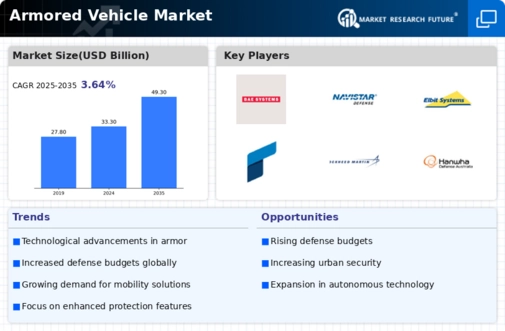
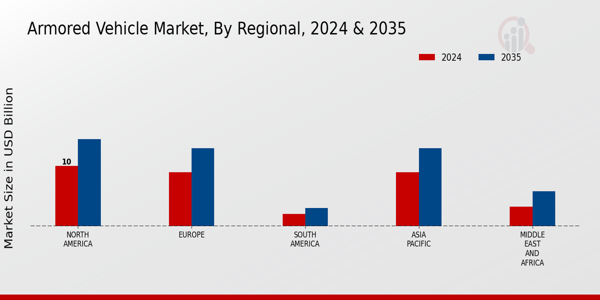


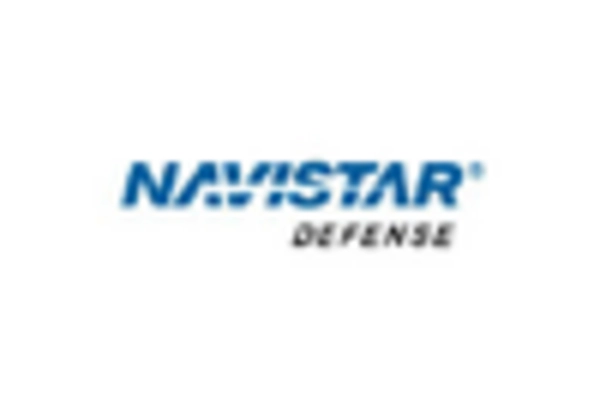
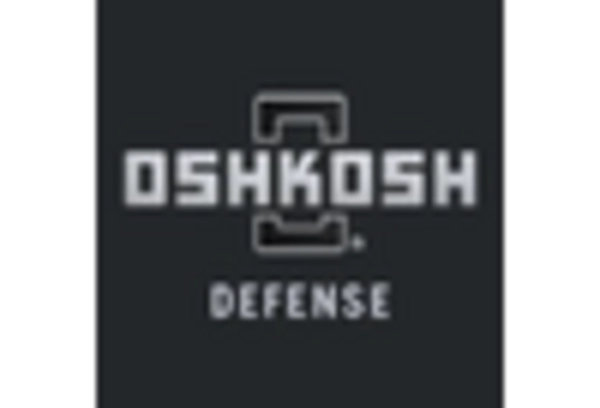
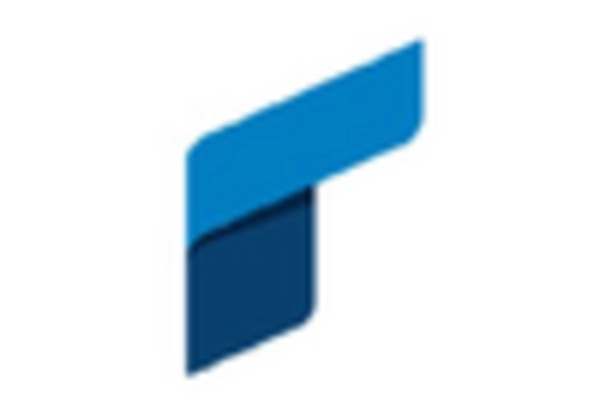


Leave a Comment